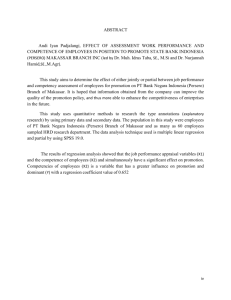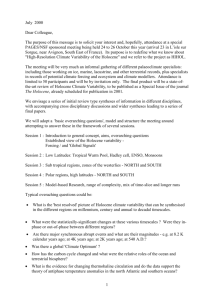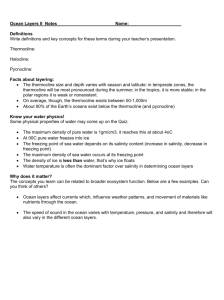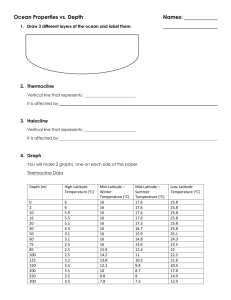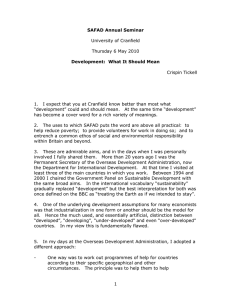Rosenthal_ITF_09292014-2.pptx
advertisement
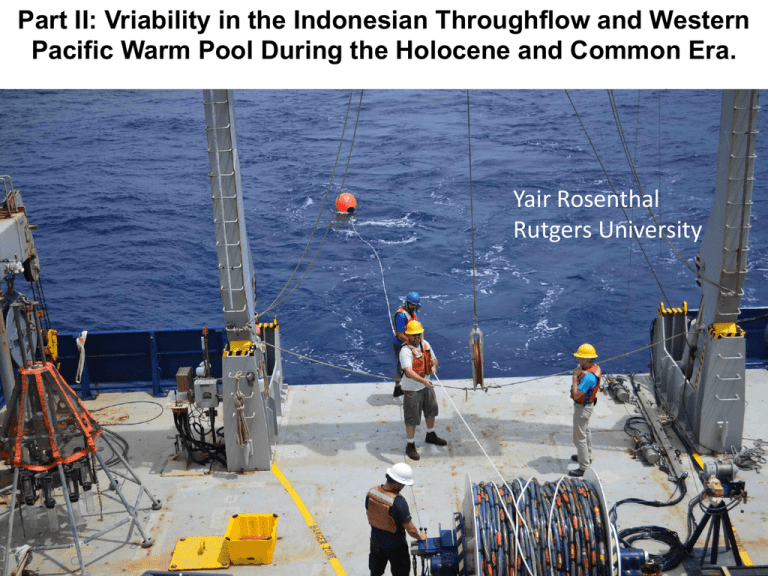
Part II: Vriability in the Indonesian Throughflow and Western Pacific Warm Pool During the Holocene and Common Era. Yair Rosenthal Rutgers University Will briefly summarize (not on Courseworks) • Oppo, D.W., Y. Rosenthal, B. K. Linsley; 2000-year-long temperature and hydrology reconstructions from the Indo-Pacific Warm Pool; Nature, vol. 460, 1113-1116, 2009. Another related paper from our group to be discussed later by Y. Rosenthal • Rosenthal, Y, B. K. Linsley, D. W. Oppo, Pacific Ocean heat content over the past 10,000 years (2013), Science, vol. 342, 617-621, November 1, 2013 Planktonic foraminifera Mg/Ca records of mixed layer temperatures in the WPWP. (A) Comparison of Indonesian and WPWP Globigerinoides ruber Mg/Ca-based surface temperature anomaly records. Anomalies calculated as departures relative to average of last 2,000 years (except for MD41, see table 1). Bold gray curve is JJA solar insolation at 0°N for reference. (B) 200 year non-overlapping binned averages of all 8 cores shown in A (black) and average of just the 4 southern Makassar region cores (green). The light green and dashed bounding lines show the standard error (SE) of all measurements in each 200 year bin. Dark gray curves are sea level reconstructions from Tahiti and Barbados. Our Preferred Explanation in 2010 was…… : A westward shift or expansion of the WPWP would explain the early Holocene elevated SSTs. This would also be in-line with observations of a more La Niña-like mean state in the early Holocene. Mg/Ca – alkenone apparent SST discrepancy Mg/Ca alkenone Mg/Ca – Tex86 SST Makassar Northern South China Sea SST Winter SST Summer SST Mean annual SST Shintani et al., 2011 Wei et al., 2007 Model-data comparison All the models suggest temperature warming throughout the Holocene (due to increase pCO2 and decrease extent of ice sheets in contrast with available data compilations. A seasonal ecological bias toward summer months or upwelling periods can account for some but not all of this). Liu et al., 2014 PANS Possible mechanisms to explain SST changes in the Indonesian Seaways 1. WPWP SST are influenced by significant input of northern Pacific water and thus exhibit signatures of northern hemisphere climate as affected by insolation Abrupt upper thermocline cooling beginning 9,500 yr BP In the Timor Sea downstream of the ITF. Xu, J., Holbourn, A., Kuhnt, W., Jian, Z. & Kawamura, H. Changes in the thermocline structure of the Indonesian outflow during Terminations I and II. Earth Planet. Sci. Lett. 273, 152–162 (2008). Thermocline temperature records along the ITF path Gibbons et al., in prep. Makassar Savu Makassar Timor Gordon 2005 Sunda Shelf flooding Increase in the atm concentrations of greenhouse gases starting ~6000 years ago Holocene changes in the mean climate State of the tropical Ocean Early to late Holocene southward migration of the Atlantic ITCZ, a record from the Cariaco Basin,Western Tropical Atlantic ( Haug et al., 2001) A record of Holocene ENSO variability from Laguna Pallcacocha, Ecuador (Moy et al., 2002 Increasing ENSO frequency or amplitude AGE A Holocene Asian monsoon record from the Dongge Cave (southern China) A southward shift of the ITCZ and weakening of the summer monsoon after ~6 ka, associated with reduced northern hemisphere summer insolation Su mmer insol ation 65 °N Wang et al., (2005) 540 530 W/M^2 520 510 500 490 480 inso(W/m2) 470 0 5 10 Age Ka 15 Possible mechanisms to explain SST changes in the Indonesian Seaways 2. A northward shift of the ITCZ in the early Holocene led to stronger cross equatorial winds and thus stronger northwestward transport of warm south Pacific tropical water at the expanse of North Pacific water following Godfrey “Island Rule”. Possible implications for ITF: Early Holocene warmer water and implied higher water transport. The southward migration of the ITCZ decreases the cross equatorial transport ITF heat transport decreases throughout the Holocene following Northern Hemisphere insolation. What about centennial-millennial variability? Makassar Strait over last 2,000 years: Below shows reconstructed Makassar Strait Sea Surface Temperature and d18Oseawater (Salinity) vs. Northern Hemisphere Air Temperature warmer Medieval Warm Period Proxy for Temperature cooler saltier Proxy for Salinity fresher From Oppo, Rosenthal and Linsley Nature, vol 460, August 27, 2009 FRESHWATER CONTROLS ON THE INDONESIAN THROUGHFLOW THERMOCLINE DURING THE LAST 2000 YEARS Julie Kalansky PhD Thesis 2014 Temperature Proxies: Sautter 1998 Mg/Ca of N. dutertrei planktonic foraminifera Anand et al. 2003; N. dutertrei calcifies at 80-100 m. Temp Error ±1.3˚C ~80 m 21 Thermocline temperature and estimated salinity changes temperature salinity MCA LIA ITF ENSO response Ffield et al. 2000 El Nino is associated with cooler temperatures and reduced flow Susanto et al. 2012 23 Effects of interannual variability of SCS water on the ITF: ENSO connection • El Nino: more restrictive to the upper ITF • La Nina: less restrictive to the upper ITF Gordon et al. (2012) Strong Luzon throughflow El Niño Weak Luzon throughflow ~100 m Mindanao Current ~100m Mindanao Current La Niña Blocked: upper ~100m 40 m 40 m Karimata transport response to local winds, slightly stronger in la nina Mindanao surface layer leakage to ITF blocked upper ~100 m Blocked: upper ~40 m Mindanao surface layer leakage blocked only in upper ~40 m La Niña effect: Warmer ITF reaches into the Indian Ocean, potentially affecting regional sea surface temperature and climate??? ITF Seasonal Monsoon Response high precipitation deep and cool thermocline flow low precipitation shallow and warm thermocline flow 25 The 2004 to 2009 Makassar Strait mean seasonal velocity (filtered). Maximum southward velocity occurs in July to September during the southeast monsoon The Makassar Strait temperature and salinity mean seasonal sections constructed from the January 2004 to November 2006 INSTANT mooring measurements (same filter). Susanto et al. 2012 The Makassar Strait potential temperature salinity curves constructed from the January 2004 to November 2006 INSTANT mooring measurements EAWM cool/fresh/ min velocity EASM warm/salty/ mx velocity Susanto et al. 2012 temperature salinity MCA LIA 28 temperature precipitation precipitation 29 Changes in the monsoon system during the Common Era Tierney et al., 2010 B. Zhang et al., 2008 C. Tierney et al., 2010 D. Emile-Geay et al., 2013 E. Moy et al., 2002 F. Conroy et al., 2008 G. Steinhilber et al., 2012 31 An intermediate water exchange through the Makassar – climate implications Water Masses passing the Makassar Straits Hyalinea balthica Restricted depth / temperature 6-12°C distribution High temp-sensitivity No [∆CO3] ion effect Easy to clean ~0.64‰ offset from d18O equilibrium Great candidate for thermocline and intermediate water reconstructions (when available) Rosenthal et al., 2011 16 12 8 4 0 Rosenthal et al., 2013 Comparing Indonesia IWT records with the surface temperature compilation of Marcott (Marcott et al., 2013; Rosenthal et al., 2013) Tidal mixing: can the surface signal reflect mixing with the IWT? Observatio n Control Run (no tidal mixing) With tidal mixing Reduce SST by 2oC inside Indonesia Seas Reduce precipitation by 20% Graphics from Sprintall et al. (2010), based on results of KochLarrouy et al. (2010) Changes in OHC over the past 10,000 years Implications to Ocean Heat Content Rosenthal et al., 2013 Thoughts We argue that the heat transport during the MCA is >0.1 PW higher than in the LIA. While this heat anomaly is not large compared with observed interannual variability, integrated over a few centuries, it potentially translates into a large perturbation. Based on this we would expect greater heat transport through the Leeuwin Current into the Indian Ocean thermocline and farther into the Agulhas Current during the MCA. This may have been one mechanism by which the Common Era climate anomalies were propagated across the equator into the southern hemisphere. Possible global effects: long term anomalies

